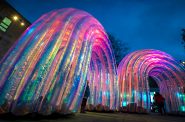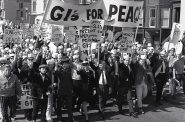The Last Decade at MAM
Andy Warhol: The Last Decade at the Milwaukee Art Museum

Andy Warhol, Self-Portrait (Strangulation), 1978. Acrylic and silkscreen ink on canvas, ten parts, 16 x 13 in. (40.6 x 33 cm) each. Collection of Anthony d’Offay.
Andy Warhol died in his sleep in 1987. The death of the artist, at 58, came a day after gall bladder surgery and at the most prolific point of his career. It was at the very time that his artistic production was in spectacular but nearly private supernova that yielded iconic self-portraits, ventures in abstraction and intensive appropriations of Leonardo da Vinci’s Last Supper.
Andy Warhol: The Last Decade illuminates these exceptionally fruitful late years and is the first major exhibition to take on this task. The Andy Warhol most of us know is the pop artist star of the 1960s, the Warhol of the Campbell’s Soup, the one who claimed everyone would have 15 minutes of fame, the man who took the heroic ardor out of the Abstract Expressionists with slick silkscreen productions churned out by Andy and assistants at a studio called The Factory.
Those first years are echoed in the late 1970s. It was the end of a decade in which Warhol’s reputation and relevancy seemed bloated and on the way to oblivion. He was loaded down with celebrity portraits, producing image-after-commissioned image of the beautiful people — Liza Minnelli, Mick Jagger, even the Shah of Iran. Warhol’s reputation had become aligned with the jet-set scene and little else.
Andy Warhol: The Last Decade points out how, in the late ’70s, he reflected on his artistic past while figuring out the present. He revisited earlier themes, such as Marilyn Monroe, but as this exhibition eloquently illustrates, Warhol had found an array of new ideas ripe for exploration. Many came weighted with a darker psychology and penchant for abstraction.
One of the first projects to draw Warhol away from the precipice of the has-beens was his Shadows series of 1978-1979, big, looming chasms inky strangeness shot through with candy colors. There’s little to overtly suggest space or depth, but we get sensations — a passage, a room, a figure, perhaps? They’re unknowable and esoteric and connect with the Warholian contradiction of picturing nothingness, yet imbuing it with substance. As Keith Hartley suggests in his catalog essay, though Warhol deemed these works “disco decor,” their murky and mysterious nature, particularly when installed as a long, continuous frieze, becomes fraught with possibility and uncertainty.

Andy Warhol, Yarn, 1983. Acrylic and silkscreen ink on linen, 40 x 40 in. (101.6 x 101.6 cm). The Andy Warhol Museum, Pittsburgh; Founding Collection, Contribution The Andy Warhol Foundation for the Visual Arts, Inc.
Warhol’s interest in abstraction is documented in a number of series. The Rorschach paintings are like psychology tests writ large – as much as 13-feet-tall large. The Oxidation Paintings and Yarn canvases also shun ordinary, painterly approaches; the former reveals the chemical reactions between urine and metallic pigments, and the latter grew from a commissioned project into giant canvases of squiggling, entwined, twisty lines. The quotations are unmistakable — the impulses of performance art and Dada on one hand, and Abstract Expressionism Warhol-style on the other.
The most poignant images throughout Andy Warhol: The Last Decade are the self-portraits, and it’s almost impossible to look at this exhibition and these pictures without a poignant sense of death over your shoulder. Warhol explored self-portraiture in his youthful glory days of the ’60s, again in the late ‘70s into the dawn of the ‘80s, and lastly in 1986. These images have an unsettling power that transcends the context of their time. His face is often blurred and repeated. Skulls hover as reminders of our terminal mortality. In the last portraits, his iconic shock of silver hair appears electrified, and he is simultaneously hidden and revealed within a wash of camouflage. These are modern parallels to the arc of self-portraiture by predecessors, such as Rembrandt van Rijn, wherein the youthful, self-assured and somewhat cocky painter is transformed through the unabashed frankness and exposed spirit in an older self.
It’s as though Warhol, a master of understated drama, fortuitously embarked on these themes just in time, as though feeling the sands of time were slipping. He was also re-energized through his work in the early 1980s with younger artists, such as Jean-Michel Basquiat and Francesco Clemente. These collaborations served as catalysts for Warhol to pick up actual paintbrushes once more.

Andy Warhol, The Last Supper, 1986. Acrylic and silkscreen on canvas, 78 x 306 in. The Baltimore Museum of Art, Purchase with exchange funds from the Harry A. Bernstein Memorial Collection. Photo: Mitro Hood.
The exhibition reaches a final crescendo with The Last Supper works, which originated in a project for a gallery in Milan, housed across from Santa Maria delle Grazie where Leonardo da Vinci painted his famed fresco between 1495 and 1498. These last images, as well as Warhol’s provocative Black and White Ads, give glimpses into the hidden Andy Warhol, suggesting his Catholic devotion and personal commentaries.
This exhibition, developed by former Milwaukee Art Museum chief curator Joseph D. Ketner II, who now holds a named chair at Emerson College in Boston, summarizes the final years of Warhol’s career neatly. The design of the exhibition is usefully spare; the wall text is unobtrusive. The paintings are left to fully dominate our attention. As large as the Baker/Rowland galleries are, unfortunate limits are imposed by walls; it feels as though this exhibition could go on at twice its length, given the extraordinary amount and variety of work produced during these years. The richness of experimentation and exploration of Warhol’s last decade is tantalizing, and it seems this story is only beginning to be told.
Andy Warhol: The Last Decade is augmented by an ongoing program of films, lectures, book discussions and ancillary exhibitions. Andy Warhol: Pop Star (located in Gallery 21 on the main level) is a small exhibition of works from the Museum collection and temporary loans. Figurative Prints: 1980s Rewind, on view in the Koss Gallery, showcases works on paper by Warhol and other major artists of the time, including Eric Fischl, Susan Rothenberg and Julian Schnabel. More information can be found on the Museum’s Warhol exhibition website.
Andy Warhol: The Last Decade
September 26, 2009 – January 3, 2010
Milwaukee Art Museum
700 N. Art Museum Drive
414-224-3200
Open Tuesdays – Sundays, 10 am – 5 pm
Open Thursdays until 8 pm
Closed on Mondays
Art
-
Winning Artists Works on Display
 May 30th, 2024 by Annie Raab
May 30th, 2024 by Annie Raab
-
5 Huge Rainbow Arcs Coming To Downtown
 Apr 29th, 2024 by Jeramey Jannene
Apr 29th, 2024 by Jeramey Jannene
-
Exhibit Tells Story of Vietnam War Resistors in the Military
 Mar 29th, 2024 by Bill Christofferson
Mar 29th, 2024 by Bill Christofferson





















Love him or hate him, Warhol was a force to be reckoned with. He had his 15 minutes of fame and then some. Much of his work seemed almost disposable in his day yet it has stood the test of time. There is a gallery of Warhol pieces in the main building that are worth checking out too, including Mao, Jackie, Marilyn, Brillo, and Campbell’s Soup. Even these many years later, this stuff is still provocative.
I see Rothenberg’s name in conjunction with the Andy W. exhibit. I have a great print of hers..the real McCoy. Anyone interested in making me an offer?
Kat, thanks for writing such a perceptive and eloquent piece for us. –Tom
I read a few topics. I respect your work and added blog to favorites.